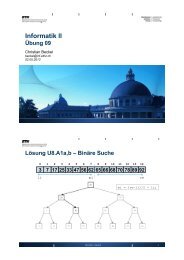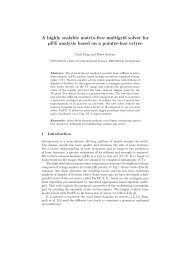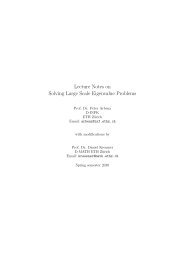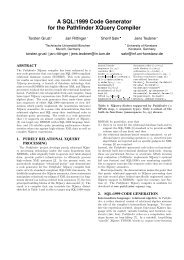Codon Evolution Mechanisms and Models
Codon Evolution Mechanisms and Models
Codon Evolution Mechanisms and Models
Create successful ePaper yourself
Turn your PDF publications into a flip-book with our unique Google optimized e-Paper software.
There is a strong correlation between the codon<br />
bias <strong>and</strong> the gene copy number of the corresponding<br />
tRNA (Ikemura, 1981a). In addition to being<br />
translated quickly, fidelity of translation is also<br />
important, in particular for abundant proteins. Misincorporations<br />
can have dire consequences <strong>and</strong><br />
cause protein misfolding (Drummond et al., 2006).<br />
A large error rate in the synthesis of crucial proteins,<br />
means that a large fraction of the proteins produced<br />
are non-functional <strong>and</strong> must be catabolized.<br />
This can carry a high cost for the organism.<br />
Selection for optimal translation is most effective<br />
in organisms with large effective population<br />
sizes (Bulmer, 1987). Indeed, strong codon bias was<br />
reported in the genomes of E. coli <strong>and</strong> yeast, which<br />
have large population sizes. Mammalian genomes<br />
have a small effective population size <strong>and</strong> there is<br />
much less evidence for selection. The codon usage<br />
in mammals is correlated to the local chromosomal<br />
nucleotide content of flanking regions <strong>and</strong> introns<br />
<strong>and</strong> mutational bias appears to be dominating the<br />
evolution of codon usage. However, there is also<br />
evidence that synonymous codon usage in mammals<br />
is not neutral (Chamary et al., 2006; Kimchi-<br />
Sarfaty et al., 2007).<br />
There is a bias in the choice of pyrimidine bases<br />
at the third position of synonymous codons such<br />
that the codon–anticodon binding has an intermediate<br />
strength in the choice of pyrimidine bases at<br />
the third position of synonymous codons (Grosjean<br />
et al., 1978; Ikemura, 1981a). If the two first positions<br />
of a codon are strong nucleotides (S = G or C, three<br />
hydrogen bonds) then the third codon position has<br />
more often a weak nucleotide (W = A or T, two<br />
hydrogen bonds). The other scenario is also true,<br />
if weak nucleotides are found at the first two positions,<br />
then the strong nucleotides are more common<br />
at the third position. This bias is independent<br />
of amino acid composition. Selection for uniform<br />
binding properties of tRNA are likely to be beneficial<br />
for translation, by preventing stalling on strong<br />
codons <strong>and</strong> insufficient binding of weak codons.<br />
Moreover, the choice of a codon in a new instance<br />
of a synonymous codon at a position downstream<br />
may be influenced by a previous occurrence, implicating<br />
the order of synonymous codons as a factor.<br />
It was found that use of a codon decoded by the<br />
same isoacceptor tRNA is preferred to other syn-<br />
CAUSES OF CODON USAGE BIAS 191<br />
onymous codons at subsequent occurrences of the<br />
same amino acid (Cannarozzi et al., 2010). As two<br />
tRNAs are simultaneously bound to the ribosome<br />
only briefly, tRNA reuse is possible at the +2 codon<br />
(Uemura et al., 2010). <strong>Codon</strong> bias in different gene<br />
regions appears to be under different selective constraints,<br />
due to the early phase of translation (Karlin<br />
et al., 1998). The first 30 to 50 codons are translated<br />
with low efficiency. In order to reduce traffic congestion<br />
of ribosomes, they form a ‘ramp’ to reduce<br />
the speed of translation in the early stage of the<br />
elongation cycle (Tuller et al., 2010). It is also possible<br />
that the codon usage acts as an extra level of regulation<br />
to fine-tune the levels of protein abundance<br />
(Begley et al., 2007; Parmley <strong>and</strong> Huynen, 2009),<br />
through the usage of regulatory codons. Further<br />
evidence for this is that the levels of protein abundance<br />
for orthologs among species are surprisingly<br />
more conserved than the mRNA levels (Weiss et al.,<br />
2010). Also, some metabolic genes are enriched in<br />
a subset of non-common codons. These codons are<br />
decoded by tRNAs that, upon amino acid starvation,<br />
are preferentially recharged over other isoacceptor<br />
tRNA (Elf et al., 2003).<br />
Other constraints on the amino acid level may<br />
shape the codon composition. There is a relationship<br />
between codon choices <strong>and</strong> the secondary<br />
structure of proteins (Adzhubei et al., 1996). For<br />
example, membrane proteins have a much higher<br />
incidence of alpha helixes, which bias the choice<br />
of codons to G-ending codons (de Mir<strong>and</strong>a et al.,<br />
2000). In eukaryotic repetitive elements, there is<br />
a small subset of codons being reiterated within<br />
homo-peptides (Faux et al., 2007). Synonymous<br />
codon usage biases may be associated with various<br />
other biological factors, such as: genome size (dos<br />
Reis et al., 2004), gene length (Duret <strong>and</strong> Mouchiroud,<br />
1999), amino acid composition (D’Onofrio<br />
et al., 1999), local protein structure (Saunders <strong>and</strong><br />
Deane, 2010), codon context, biased gene conversion<br />
(Harrison <strong>and</strong> Charlesworth, 2011), recombination<br />
rate (Zhou et al., 2005), gene translation initiation<br />
signal (Qin et al., 2004), <strong>and</strong> length of 3’-UTR.<br />
Global codon bias has been shown to correlate with<br />
GC content (Ikemura, 1981a; Kanaya et al., 2001;<br />
Knight et al., 2001), tRNA content (Kanaya et al.,<br />
2001), <strong>and</strong> organism growth temperature (Lao <strong>and</strong><br />
Forsdyke, 2000), although the latter may influence









